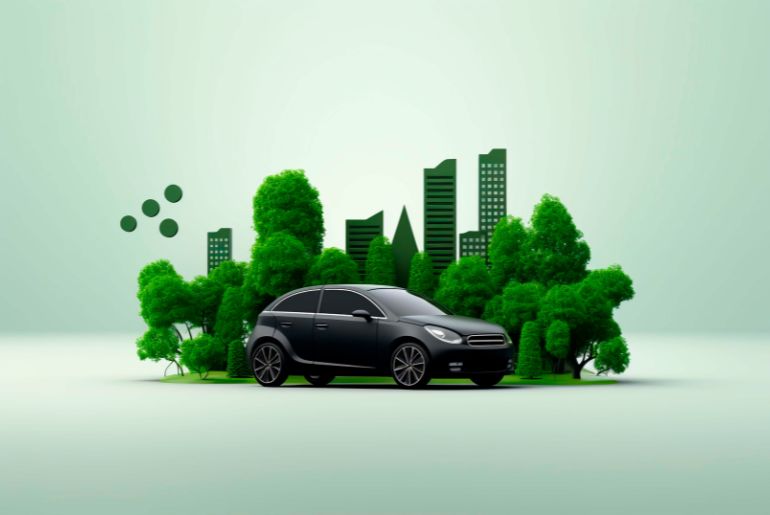World Zero Emissions Day: More Than Just EVs
On World Zero Emissions Day (September 21), the focus is often on the rapid adoption of electric vehicles (EVs). With transport contributing 14% of India’s CO₂ emissions—and road transport responsible for 90% of that (PIB)—EVs are rightly celebrated as a key part of the green mobility shift.
But here’s the conflict: EVs emit nothing from their tailpipes, yet they have massive embodied emissions in the supply chain. The true climate challenge lies not just in what EVs emit on the road but in what it takes to build them.
The EV Supply Chain Challenge: Tailpipe vs Lifecycle
A conventional petrol or diesel vehicle’s climate impact is dominated by fuel use. For EVs, it’s different. A recent study estimates that batteries alone account for 35–40% of an EV’s overall lifecycle emissions. From extracting lithium, cobalt, and nickel to processing and assembling battery packs, the resource and energy intensity is staggering. Although EVs cut tailpipe CO₂, their production carbon footprint is several times the size of conventional internal combustion vehicles. Unmitigated, India runs the risk of trading oil dependence for an equally unsustainable dependence on imported minerals and carbon-intensive manufacturing.
And let us not forget the waste: India can anticipate producing 4.5 million tonnes of EV battery waste by the year 2030. Inefficiently treated, this has the potential to neutralise the reductions in emissions being anticipated from transport electrification.
Why Circularity Carbon Credits Are Needed
That’s where circularity carbon credits come in.
Circularity carbon credits incentivise companies for quantifiable reduction of embedded emissions across the EV lifecycle. In contrast to business-as-usual carbon credits targeted at emissions prevention or reduction across the cycle, circularity carbon credits meet the “hidden” emissions trapped in EV supply chains directly.
For instance:
• Batteries can be recycled to reclaim as much as 95% of lithium, cobalt, and nickel (WEF), precluding the need for virgin mining and lowering emissions from production.
• Second-life applications—such as using retired EV batteries for grid storage—extend the useful life of these high-carbon products, delaying waste and maximising their climate value.
• Circular resource recovery allows OEMs to reintroduce materials into manufacturing, cutting the embodied carbon of new EVs.
By monetising these circular actions, circularity carbon credits provide a financial mechanism to offset the lifecycle emissions of EVs. In other words, they allow the EV ecosystem to go beyond tailpipe-zero and work toward true lifecycle-zero.
Waste Management & Recycling Principles for EVs
Circularity applies the classic reduce–reuse–recycle mantra to EVs:
• Reduce material intensity through design efficiency and localised supply chains.
Energy storage, microgrids, and integration of renewables through second-life use of batteries.
• Industrial-scale recycling for critical mineral recovery, lowering emissions from virgin material consumption.
India is already testing on a pilot basis urban circular hubs, OEM-driven collection networks, and government-incentive recycling programmes.
These pilots, in combination with carbon credits, are cost-effective and scalable.
India’s Roadblocks to Circularity
There exists robust potential, but challenges persist too:
• Infrastructure gaps: Currently, there are not enough large-scale recycling facilities and reverse logistics networks.
• Capital-intensive initial cost: Recycling technologies are capital-intensive.
• Verification complexity: Carbon credit schemes need to demonstrate additionality and transparency, which is still an issue
• OEM involvement: Although some OEMs take the lead, involvement depends on the region.
All these issues speak volumes as to why circularity credits are not just desirable but necessary—they create the added economic incentive to cover cost and infrastructure gaps.
Policy and Market Forces Driving Change
The winds are shifting. India’s carbon credit market is projected to reach $10 billion by 2030. The 2025–26 Union Budget prioritised ESG and circular economy initiatives, and upcoming COP30 discussions are expected to push global frameworks for circularity and lifecycle emissions.
Indian OEMs and recyclers are already starting to recognise circularity as a competitive imperative, rather than a compliance requirement. Carbon credits will enable organisations to reduce their embodied emissions while also leveraging their climate leadership.
The Way Forward: Toward Lifecycle-Zero EVs
The message is unequivocal: EVs resolve the problem of the tailpipe but signal a need to deal with embedded emissions. Carbon credits for circularity bridge the gap by curbing and avoiding lifecycle emissions and thus help EVs realise their potential of net climatic value.
For India, the promise is two-pronged:
1. Recycling, second-life application, and low-carbon material sourcing are some of the methodologies that can be leveraged by India to decarbonise its EV supply chain.
2. Lead globally by embedding circularity credits into its next carbon market—taking forward efforts such as MMCM’s ELV Carbon Credit Project.
On this World Zero Emissions Day, the core insight is this: the greenest EV may not necessarily be the one releasing nothing from the tailpipe but the one based on a circular, low-carbon supply chain.
by Mr. Yashodhan Ramteke, Head Carbon BU, MMCM

